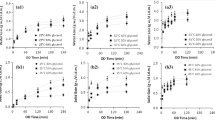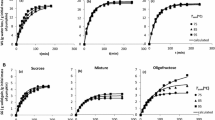Abstract
The aim was to study the effect of alternative sweeteners on the mass transfer of osmodehydrated (OD) tomato before a traditional candying process. During OD pretreatment, osmotic solute type (sucrose S, oligofructose O, sucrose and oligofructose SO, palatinose (isomaltulose)/polydextrose and steviol glucosides and oligofructose PSO/ISO, palatinose (isomaltulose)/polydextrose and steviol glucosides and maltodextrin PSM/ISM), concentration (65–75 °Brix), and temperature (75–95 °C) effect were investigated. A multivariate analysis was conducted by means of principal component analysis (PCA) and a polynomial model was proposed, to investigate the main effects of OD on mass transfer and water activity, aw as a function of the process variables. The increase of temperature and solute concentration favored, in most cases, the increase of mass transfer. Sucrose and oligofructose were the most effective osmotic solutes for solid gain (SG)-water activity (aw) decrease and water loss (WL), respectively. To achieve increased mass transfer, SO, ISO, and PSO could be used followed by PSM and ISM. When oligofructose is used, SG and aw changes are more pronounced (desired for candying). In the contrary, when introducing maltodextrin in OD solutions, milder mass exchange phenomena are observed, in all process conditions. The total or partial substitution of sucrose with alternative sweeteners (isomaltulose, steviol glucosides) and ingredients with health benefits (oligofructose) could add significant advantages to the osmodehydrated candied product. Nonetheless, the final aw of all dehydrated tomatoes ranged from 0.80 to 0.96 indicating that OD did not lead to microbiologically stable products, and thus another processing step (e.g., air-drying) should be complimentary applied.







Similar content being viewed by others
References
Ahmed, I., Qazi, I. M., & Jamal, S. (2016). Developments in osmotic dehydration technique for the preservation of fruits and vegetables. Innovative Food Science and Emerging Technologies, 34, 29–43. https://doi.org/10.1016/j.ifset.2016.01.003.
Amami, E., Khezami, L., Vorobiev, E., & Kechaou, N. (2008). Effect of pulsed electric field and osmotic dehydration pretreatment on the convective drying of carrot tissue. Drying Technology, 26(2), 231-238. https://doi.org/10.1080/07373930701537294
Aminzadeh, R., Sargolzaei, J., & Abarzani, M. (2012). Preserving melons by osmotic dehydration in a ternary system followed by air-drying. Food and Bioprocess Technology, 5(4), 1305–1316. https://doi.org/10.1007/s11947-010-0488-0.
AOAC. (1990). Official methods of analysis of AOAC INTERNATIONAL (15th ed.). USA: AOAC International.
Bchir, B., Besbes, S., Attia, H., & Blecker, C. (2009). Osmotic dehydration of pomegranate seeds: mass transfer kinetics and differential scanning calorimetry characterization. International Journal of Food Science & Technology, 44(11), 2208–2217. https://doi.org/10.1111/j.1365-2621.2009.02061.x.
Bchir, B., Besbes, S., Karoui, R., Attia, H., Paqnot, M., & Blecker, C. (2012). Effect of air-drying conditions on physico-chemical properties of osmotically pre-treated pomegranate seeds. Food and Bioprocess Technology, 5(5), 1840–1852. https://doi.org/10.1007/s11947-010-0469-3.
Brochier, B., Marczak, L. D. F., & Norena, P. Z. (2015). Osmotic dehydration of yacon using glycerol and sorbitol as solutes: water effective diffusivity evaluation. Food and Bioprocess Technology, 8(3), 623–636. https://doi.org/10.1007/s11947-014-1432-5.
Cortés-Olmos, C., Leiva-Brondo, M., Roselló, J., Raigónc, M. D., & Cebolla-Cornejo, J. (2014). The role of traditional varieties of tomato as sources of functional compounds. Journal of the Science of Food and Agriculture, 94(14), 2888–2904. https://doi.org/10.1002/jsfa.6629.
Dermesonlouoglou, E. K., Giannakourou, M. C., & Taoukis, P. (2007). Stability of dehydrofrozen tomatoes pretreated with alternative osmotic solutes. Journal of Food Engineering, 78(1), 272-280. https://doi.org/10.1016/j.jfoodeng.2005.09.026
Dermesonlouoglou, E. K., & Giannakourou, M. C. (2018). Modelling dehydration of apricot in a non-conventional multi-component osmotic solution: effect on mass transfer kinetics and quality characteristics. Journal of Food Science and Technology, 55(10), 4079–4089. https://doi.org/10.1007/s13197-018-3334-4.
Dermesonlouoglou, E. K., & Giannakourou, M. C. (2019). Evaluation and modelling of osmotic pre-treatment of peach using alternative agents in a multiple-component solution. Journal of the Science of Food and Agriculture, 99(3), 1240–1249. https://doi.org/10.1002/jsfa.9296.
Dermesonlouoglou, E., Zachariou, I., Andreou, V., & Taoukis, P. (2016). Effect of pulsed electric fields on mass transfer and quality of osmotically dehydrated kiwifruit. Food and Bioproducts Processing, 100, 535–544. https://doi.org/10.1007/s13197-018-3142-x.
Derossi, A., Severini, C., Del Mastro, A., & De Pilli, T. (2015). Study and optimization of osmotic dehydration of cherry tomatoes in complex solution by response surface methodology and desirability approach. LWT - Food Science and Technology, 60(21), 641–648. https://doi.org/10.1016/j.lwt.2014.10.056.
Eren, İ., & Kaymak-Ertekin, F. (2007). Optimization of osmotic dehydration of potato using response surface methodology. Journal of Food Engineering, 79(1), 344–352. https://doi.org/10.1016/j.jfoodeng.2006.01.069.
Fito, P., Chiralt, A., Barat, J. M., Andrés, A., Martínez-Monzó, J., & Martínez-Navarrete, N. (2001). Vacuum impregnation for development of new dehydrated products. Journal of Food Engineering, 49(4), 297–302. https://doi.org/10.1016/s0260-8774(00)00226-0.
Giovanelli, G., Zanoni, B., Lavelli, V., & Nani, R. (2002). Water sorption, drying and antioxidant properties of dried tomato products. Journal of Food Engineering, 52(2), 135–141. https://doi.org/10.1016/S0260-8774(01)00095-4.
Katsoufi, S., Lazou, A. E., Giannakourou, M. C., & Krokida, M. K. (2017). Mass transfer kinetics and quality attributes of osmo-dehydrated candied pumpkins using nutritious sweeteners. Journal of Food Science and Technology, 54(10), 3338–3348. https://doi.org/10.1007/s13197-017-2786-2.
Krasnova, I., Seglina, D., & Pole, V. (2018). The effect of pre-treatment methods on the quality of dehydrated candied Japanese quince fruits during storage. Journal of Food Science and Technology, 55(11), 4468–4476. https://doi.org/10.1007/s13197-018-3375-8.
Liu, B., & Peng, B. (2017). Modelling and optimization of process parameters for strawberry osmotic dehydration using central composite rotatable design. Journal of Food Quality, 2017, 1–7. https://doi.org/10.1155/2017/2593213.
Lombard, G. E., Oliveira, J. C., Fito, P., & Andrés, A. (2008). Osmotic dehydration of pineapple as a pre-treatment for further drying. Journal of Food Engineering, 85(2), 277–284. https://doi.org/10.1016/j.jfoodeng.2007.07.009.
Luo, W., Tappi, S., Wang, C., Yu, Y., Zhu, S., & Rocculi, P. (2018). Study and optimization of high hydrostatic pressure (HHP) to improve mass transfer and quality characteristics of candied green plums (Prunus mume). Journal of Food Processing and Preservation, 42(11), e13769. https://doi.org/10.1111/jfpp.13769.
>une Mune, M. A., & Minka, S. R. (2017). Production and characterization of cowpea protein hydrolysate with optimum nitrogen solubility by enzymatic hydrolysis using pepsin. Journal of the Science of Food and Agriculture, 97(8), 2561–2568. https://doi.org/10.1002/jsfa.8076.
Noshad, M., Mohebbi, M., Shahidi, F., & Mortazavi, S. A. (2012). Multi-objective optimization of osmotic–ultrasonic pretreatments and hot-air drying of quince using response surface methodology. Food and Bioprocess Technology, 5(6), 2098–2110. https://doi.org/10.1007/s11947-011-0577-8.
Nowicka, P., Wojdylo, A., Lech, K., & Figiel, A. (2015). Influence of osmodehydration pretreatment and combined drying method on the bioactive potential of sour cherry fruits. Food and Bioprocess Technology, 8(4), 824–836. https://doi.org/10.1007/s11947-014-1447-y.
Nunes, C., Santos, C., Pinto, G., Lopes-da-Silva, J. A., Saraiva, J. A., & Coimbra, M. A. (2008). Effect of candying on microstructure and texture of plums (Prunus domestica L.). LWT - Food Science and Technology, 41(10), 1776–1783.
Nunes, C., Santos, C., Pinto, G., Silva, S., Lopes-da-Silva, J. A., Saraiva, J. A., & Coimbra, M. A. (2009). Effects of ripening on microstructure and texture of “Ameixa d’Elvas” candied plums. Food Chemistry, 115(3), 1094–1101. https://doi.org/10.1016/j.foodchem.2008.12.089.
Panagiotou, M., Karathanos, V., & Maroulis, Z. (1998). Mass transfer modelling of the osmotic dehydration of some fruits. Journal of Food Science and Technology, 33(3), 267–284. https://doi.org/10.1046/j.1365-2621.1998.00167.x.
Rao, S. N., & Barringer, S. A. (2005). Timing of calcium treatment on resistance of raw and canned diced tomatoes to mechanical abuse. Journal of Food Processing and Preservation, 29(1), 1–7. https://doi.org/10.1111/j.1745-4549.2005.00008.x.
Rubio-Arraez, S., Capella, J. V., Ortolá, M. D., & Castelló, M. L. (2015). Modelling osmotic dehydration of lemon slices using new sweeteners. International Journal of Food Science and Technology, 50(9), 2046–2051. https://doi.org/10.1111/ijfs.12859.
Salim, N. S. M., Gariepy, Y., & Raghavan, V. (2019). Effects of processing on quality attributes of osmo-dried broccoli stalk slices. Food and Bioprocess Technology, 12(7), 1174–1184. https://doi.org/10.1007/s11947-019-02282-2.
Samuel, P., Ayoob, K. T., Magnuson, B. A., Wölwer-Rieck, U., Jeppesen, P. B., Rogers, P. J., Rowland, I., & Mathews, R. (2018). Stevia leaf to stevia sweetener: exploring its science, benefits, and future potential. The Journal of Nutrition, 148(7), 1186S–1205S. https://doi.org/10.1093/jn/nxy102.
Sawale, P. D., Shendurse, A. M., Mohan, M. S., & Patil, G. R. (2017). Isomaltulose (palatinose)–an emerging carbohydrate. Food Bioscience, 18, 46–52. https://doi.org/10.1016/j.fbio.2017.04.003.
Shyam, S., Ramadas, A., & Chang, S. K. (2018). Isomaltulose: recent evidence for health benefits. Journal of Functional Foods, 48, 173–178. https://doi.org/10.1016/j.jff.2018.07.002.
Tan, V. W. K., Wee, M. S. M., Tomic, O., & Forde, C. G. (2019). Temporal sweetness and side tastes profiles of 16 sweeteners using temporal check-all-that-apply (TCATA). Food Research International, 121, 39–47. https://doi.org/10.1016/j.foodres.2019.03.019.
Terkmane, N., Krea, M., & Moulai-Mostefa, N. (2016). Optimisation of inulin extraction from globe artichoke (Cynara cardunculus L. subsp. scolymus (L.) Hegi) by electromagnetic induction heating process. International Journal of Food Science and Technology, 51(9), 1997–2008. https://doi.org/10.1111/ijfs.13167.
Tian, Y., Deng, Y., Zhang, W., & Mu, W. (2019). Sucrose isomers as alternative sweeteners: properties, production, and applications. Applied Microbiology and Biotechnology, 103(21), 8677–8687. https://doi.org/10.1007/s00253-019-10132-6.
Torreggiani, D., & Bertolo, G. (2004). Present and future in process control and optimization of osmotic dehydration: from unit operation to innovative combined process: an overview. Advances in Food and Nutrition Research, 48, 173–238. https://doi.org/10.1016/S1043-4526(04)48004-8.
Vilela, A., Sobreira, C., Abraão, A. S., Lemos, A. M., & Nunes, F. M. (2016). Texture quality of candied fruits as influenced by osmotic dehydration agents. Journal of Texture Studies, 47(3), 239–252. https://doi.org/10.1111/jtxs.12177.
Acknowledgments
The authors would like to acknowledge Ms. Anastasia Theodoropoulou, Ms. Vasiliki Perivolari, and Mr. Panagiotis Papadopoulos for the technical assistance in the experimental procedure.
Author information
Authors and Affiliations
Corresponding author
Additional information
Publisher’s Note
Springer Nature remains neutral with regard to jurisdictional claims in published maps and institutional affiliations.
Rights and permissions
About this article
Cite this article
Lazou, A.Ε., Dermesonlouoglou, E.K. & Giannakourou, M.C. Modeling and Evaluation of the Osmotic Pretreatment of Tomatoes (S. lycopersicum) with Alternative Sweeteners for the Production of Candied Products. Food Bioprocess Technol 13, 948–961 (2020). https://doi.org/10.1007/s11947-020-02456-3
Received:
Accepted:
Published:
Issue Date:
DOI: https://doi.org/10.1007/s11947-020-02456-3




